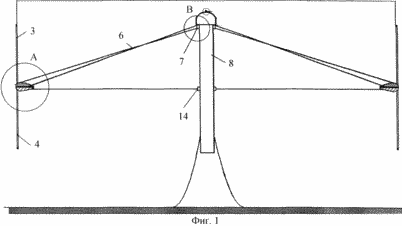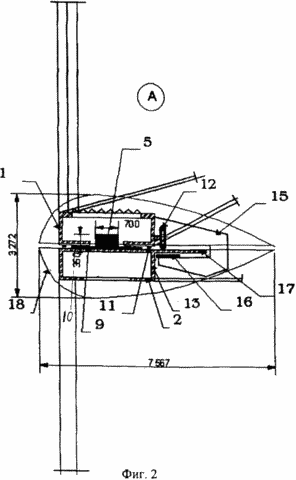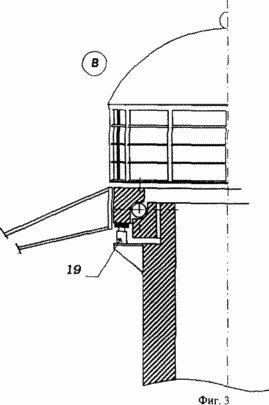| Start of section
Production, amateur Radio amateurs Aircraft model, rocket-model Useful, entertaining |
Stealth Master
Electronics Physics Technologies Inventions |
Secrets of the cosmos
Secrets of the Earth Secrets of the Ocean Tricks Map of section |
|
| Use of the site materials is allowed subject to the link (for websites - hyperlinks) | |||
Navigation: => |
Home / Patent catalog / Catalog section / Back / |
|
INVENTION
Patent of the Russian Federation RU2245456
![]()
VETROENERGETICAL INSTALLATION WITH VERTICAL AXIS OF ROTATION
The name of the inventor: Viktor Lyatcher
The name of the patent owner: Lytkher Viktor Mikhailovich
Address for correspondence: 125363, Moscow, ul. Shturvalnaya, 5-1-129, VM Lahter
Date of commencement of the patent: 2002.05.22
A wind power plant with a vertical axis of rotation refers to wind power, in particular to rotary wind power installations. The technical result is to increase the reliability and efficiency. The installation comprises one above the other two annular rotor blades, a linear generator between them and a central pylon connected to the rotors. The blades on the ring rotors are oriented in the opposite way to ensure the counter rotation of the rotors. The upper rotor is connected to the central pylon stretch system fixed to the outer ring of the radial thrust bearing, and the lower rotor is connected to the upper rotor by an electromagnetic suspension system and unloaded wheel bearings fixing the vertical gap between the elements of the linear generator. The upper rotor is equipped with L-shaped consoles bearing brake linings on which the lower rotor brake shelf is placed when the suspension electromagnets are disconnected.
DESCRIPTION OF THE INVENTION
The invention relates to wind power, namely to rotary power units, and can be used to generate energy from air currents.
There are known wind turbines with a vertical axis of rotation with a support in the form of a central fixed pylon on which a fixed ring supporting a stator of the generator is fixed around the cable, carrying a vertical ring and a rotor of a linear generator with the help of wire braces. (USSR author's certificate No. 1366686).
The disadvantage of this solution is the need to accurately manufacture a large diameter rolling ring for transferring lateral forces to stationary supports. In addition, due to the relatively low speed of the mobile ring, the mass of the linear generator is relatively large and accordingly the cost of the generator is high.
The closest to this invention is a wind turbine with a vertical axis of rotation in which the annular rotor blade (CLR) is suspended on a cable system to the central pylon through a radially thrust bearing using pairwise spaced and intersecting stretch marks subjected to tensile stress due to centrifugal action Forces and weight of the CLR (USSR Authors' Certificate No. 1671953). The disadvantage of this technical solution is the presence in the central pylon of a mechanical multiplier, which increases the frequency of rotation of the working shaft of the electric generator located there, which significantly increases the cost of installation, increases operating costs and reduces its reliability.
The technical result of the invention is to increase reliability and, in addition, to increase economic efficiency.
The technical result is achieved in that in a wind power plant with a vertical axis of rotation containing annular rotor blades, linear generators and a central pylon connected to the rotors, the annular rotor rotors are mounted one above the other with a linear generator between them, the blades on the ring rotors are oriented in the opposite way with the possibility Counter rotation of the rotors.
In addition, in the wind power plant, the upper rotor is connected to a central pylon stretch system fixed to the outer ring of the radial thrust bearing, and the lower rotor is connected to the upper rotor by an electromagnetic suspension system and unloaded wheel bearings that fix the vertical gap between the elements of the linear generator.
In addition, in the wind power plant, the upper rotor is equipped with L-shaped consoles bearing brake linings on which the lower rotor brake shelf is placed when the electromagnetic suspension is disconnected.
The technical result is achieved by the fact that the rotors and the extensions adjacent to the rotor are equipped with aerodynamic fairings, the upper fairing in the nose part having a descent overlapping the horizontal slot between the fairings, and the parts of the fairings adjacent to the rotors are provided with aerodynamic brake flaps opening at the The excess of the rated speed of the rotors or the signal from the control system that controls the operation of the plant.
In addition, in the wind power plant, the inductors of the linear generator are combined into blocks having different nominal armature speeds and operating on the electric network in a certain range of wind speed variation.
The proposed technical solution, unlike the above-mentioned rotor wind power units, carries blades oriented in the opposite way, which provides high relative speeds between the inductors of the linear generator and the conductive plate, which reduces the mass of the inductors and increases the economics of the installation.
The counter rotation of the rotors releases the central pylon from the torque developed by the blades and ensures mutual compensation of the lateral forces acting on the rotors, which reduces the total load on the central pylon, reduces the material consumption and increases the reliability of the wind power plant.
Combining the inductors into blocks with different nominal armature speeds allows us to start using wind energy from relatively small wind speeds and provides a high energy efficiency of the wind power plant in the entire significant range of wind speed changes due to the optimal choice of the rotation speed of the rotors for each range of wind speed variations.
 |
 |
 |
1 shows a general view of the wind power plant. FIG. 2 shows in a vertical section a rotor block of a wind power plant. 3, in a vertical section, a portion of the central pylon is shown where a mechanical parking brake is located. Wind power installation includes one above the other two ring rotors 1 and 2 in the form of regular polygons, on which the blades of aerodynamic profile 3 and 4 are vertically fixed, oriented in opposite directions. The upper annular rotor 1 carrying the inductors of the linear generator 5, the extensions 6 is connected to the radial-thrust bearing 7 located at the top of the central pylon 8. The lower annular rotor 2, carrying the strip 9 of the electrically conductive material and the magnetic core 10, is suspended from the upper annular rotor 1 by means of Electromagnets of vertical action 11 providing a fixed gap between the inductors 5 and the strip 9 controlled by special sensors and polyamide wheels 12 whose axes are fixed on the rotor 1 and the working surface rolls along the path on the rotor 2. The annular rotor 2 is tensioned by the horizontal stretches 13, Connecting it with a radial bearing 14 fixed to the central pylon 8. |
The upper rotor 1 is provided with L-shaped brackets 15 carrying brake linings 16 on which the brake shelf 17 of the lower rotor 2 lies when the suspension electromagnets are disconnected. The upper and lower rotors 1 and 2, a and the adjacent stretch segments 6 are protected by the fairings of the aerodynamic profile 18, the upper fairing in the nose having a vertical descent overlapping the horizontal slot between the fairings.
The parts of the fairings closing the rotors are equipped with aerodynamic brake flaps (not shown) that open when the speed of the rotors' movement is exceeded or at the signal of the control system that controls the operation of the wind power plant.
On the central pylon 8 in the area of the radial-thrust bearing 7 there is a mechanical parking brake 19 fixing the position of the rotors of the inoperative wind power installation and performing emergency braking functions.
The inductors of the linear generator 5 are combined into blocks having different nominal armature speeds and operating on an electrical network in a certain range of wind speed variation. The inductor blocks of the linear generator are combined by power electric cables, which are pulled out to the central pylon 8, where the current collector rings are located, which ensure the delivery of electrical power to the network.
When the wind power plant is in operation, the arrangement of the rotors 1 and 2, each of which carries blades 3 and 4 oriented in opposite directions, creates a counter rotation of the rotors 1 and 2 and, respectively, twice the relative speed of the linear generator elements 5 placed on the rotors. In addition, the counter rotation of the rotors releases The central pylon 8 from the torque developed by the blades 3 and 4. The rotation of these blades is transferred to the elements of a linear generator 5 operating on an electrical network. Braking is carried out by brake pads 16 located on the L-shaped consoles 15 of the upper rotor 1, on which the brake shelf 17 of the lower rotor 2 lies when the suspension electromagnets are disconnected. The protection of the rotors 1 and 2, as well as of the adjacent stretch segments 6, is carried out by the fairings of the aerodynamic profile 18. The emergency braking function is provided by the parking brake 19, which fixes the position and position of the rotors 1 and 2 of the inoperative plant.
In addition, the wind power plant uses a system of automatic control and monitoring, including wind speed, phase power, output, vibration, data analysis, issuing control commands and mechanisms for implementing commands.
CLAIM
1. A wind power plant with a vertical axis of rotation, comprising annular rotor blades, linear generators and a central pylon connected to the rotors, characterized in that the annular rotor blades are mounted one above the other with a linear generator between them, the blades on the annular rotors are oriented in the opposite way - Counter rotation of the rotors.
2. Wind power plant according to claim 1, characterized in that the upper rotor is connected to a central pylon system of extensions fixed to the outer ring of the radial-thrust bearing, and the lower rotor is connected to the upper rotor by an electromagnetic suspension system and unloaded wheel bearings fixing the vertical gap between Elements of a linear generator.
3. Wind power plant according to claim 1 or 2, characterized in that the upper rotor is provided with L-shaped brackets carrying brake linings on which the lower rotor brake shelf is placed when the electromagnetic suspension is disconnected.
4. Wind power plant according to claim 1 or 2 or 3, characterized in that the rotors, the extensions adjacent to the rotor, are equipped with aerodynamic fairings, the upper fairing in the nose part having a descent overlapping the horizontal slot between the fairings, and parts of the fairings, Adjacent to the rotors, are equipped with aerodynamic brake flaps that open when the rotors exceed the estimated speed of motion or at the signal of the control system that controls the operation of the plant.
5. Wind power plant according to any one of claims 1 to 4, characterized in that the inductors of the linear generator are combined into blocks having different nominal armature speeds and operating on the electric network in a certain range of wind speed variation.
print version
Date of publication 02.02.2007gg




Comments
When commenting on, remember that the content and tone of your message can hurt the feelings of real people, show respect and tolerance to your interlocutors even if you do not share their opinion, your behavior in the conditions of freedom of expression and anonymity provided by the Internet, changes Not only virtual, but also the real world. All comments are hidden from the index, spam is controlled.